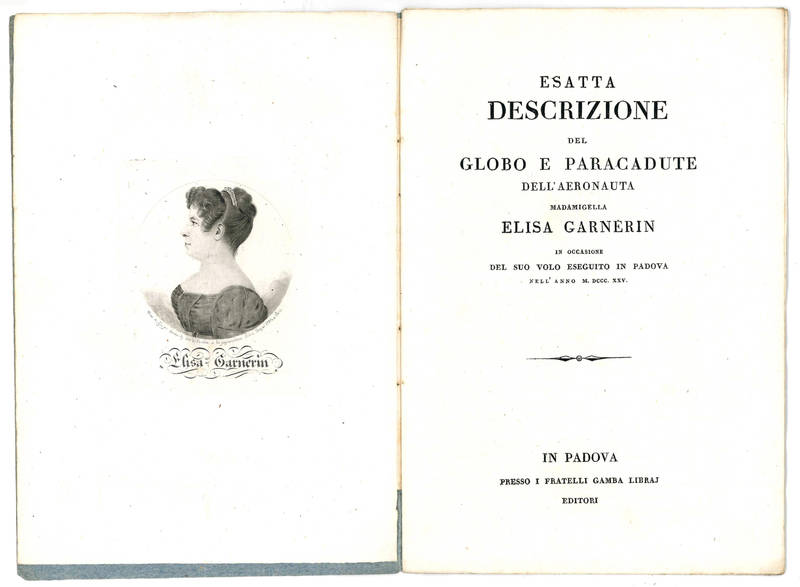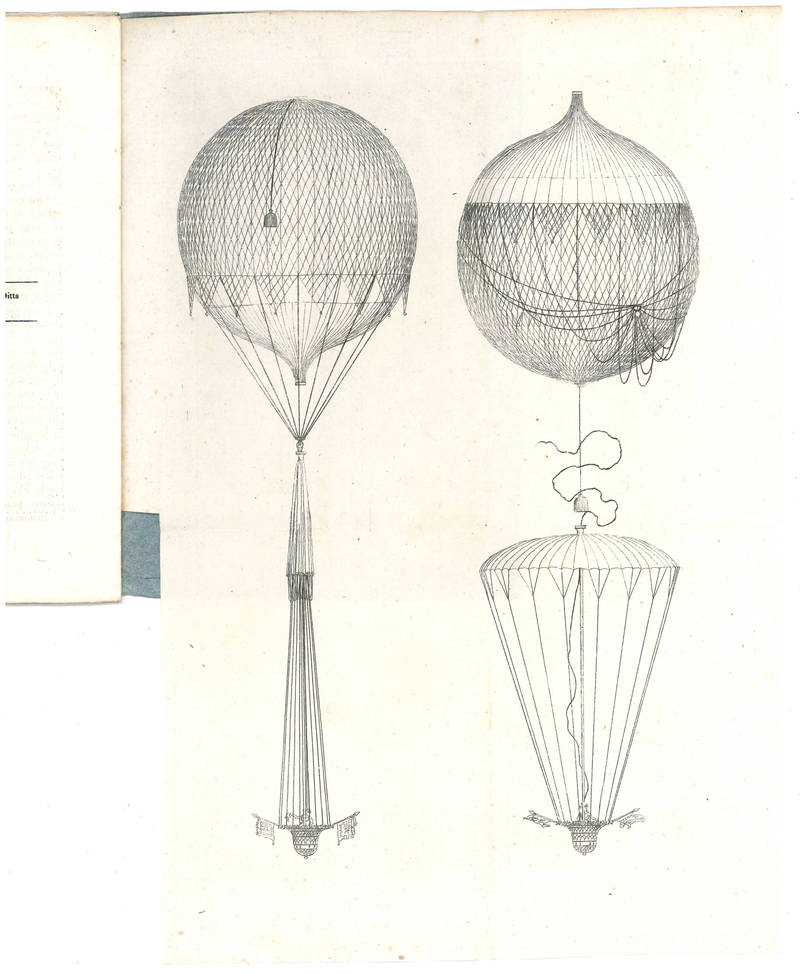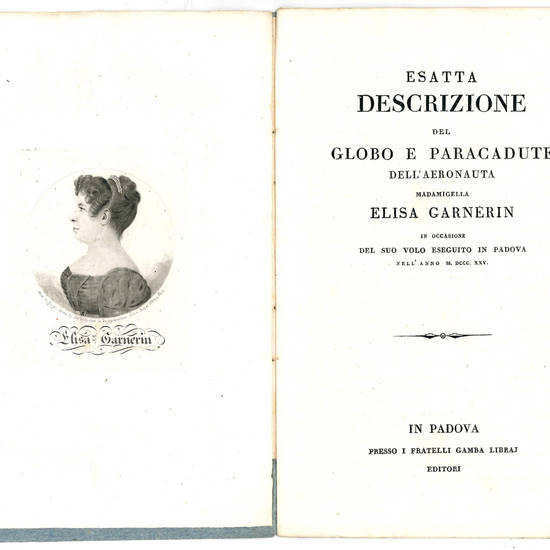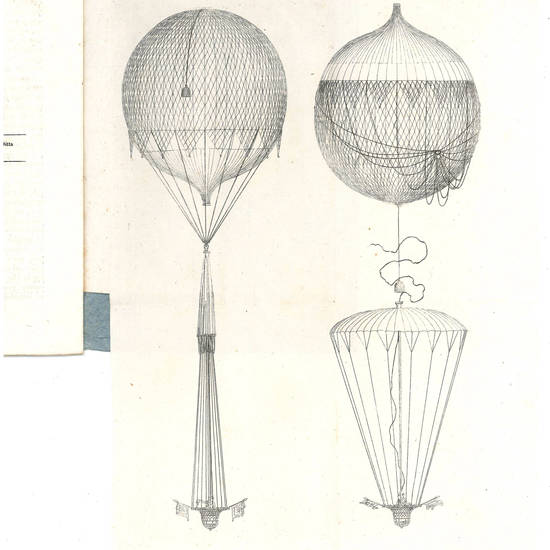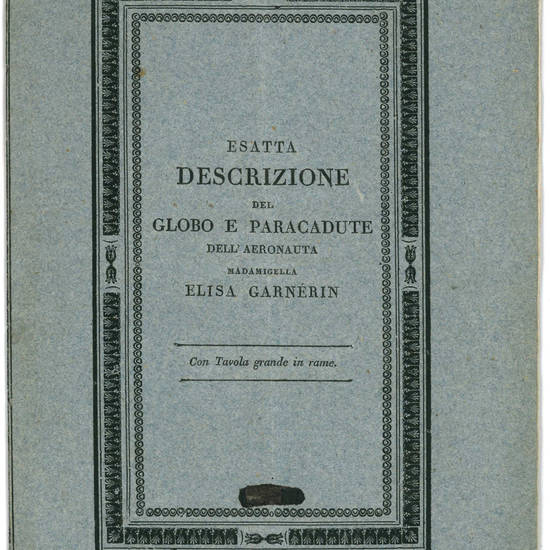Esatta descrizione del Globo e Paracadute dell'Aeronauta Madamigella Elisa Garnérin in occasione del suo volo eseguito in Padova nell'anno MDCCCXXV
Autore: GARNERIN, Élisa (1791-1853)
Tipografo: Presso i Fratelli Gamba (Dalla Nuova Società Tipografica in Ditta N. Zanon Bettoni e Compagni-Dalla Tipografia e Fonderia della Minerva)
Dati tipografici: Padova, [1825]
THE FIRST WOMAN PARACHUTIST
8vo (213x145 mm). Garnerin's engraved portrait as a frontispiece, 7, [1] pp. and one engraved folding plate depicting the balloon and the parachute before and after their disjunction. Original printed wrappers. A nearly perfect copy.
Very rare pamphlet reporting the twenty-fifth flight made in Padua in 1825 by the famous parachutist Élisa Garnerin, niece of André-Jacques Garnerin (1769-1823) and Geneviève Labrosse, who, in 1797 and 1798 respectively, made the first real parachute jump. Elisa learned from her uncles how to fly a balloon at the age of fifteen, and in her lifetime carried out no less than thirty-nine parachute jumps between 1815 and 1836, performing in Italy, Spain, France, Germany, and even Russia (S.L. Kotar & J.E. Gessler, Ballooning: A History, 1782-1900, Jefferson NC-London, 2011, pp. 81-82).
The present Descrizione informs us of the dimensions and features of the balloon and parachute used by Garnérin and also reports on the “mezzo facilissimo immaginato per ricuperare il pallone, allorché resta nell'aria separato dal paracadute. Esso consiste in un peso assicurato sulla sommità del globo dalla rete, la quale lo tiene obbligato nel centro mediante il sottoposto contrappeso, molto maggiore del paracadute carico della volatrice: ed allorché essa si separa dal pallone, questo si capovolge, e lasciando sortire il gas dal tubo per cui fu introdotto, cade tosto pur esso a poca distanza dalla navicella” (‘very easy means imagined for recovering the balloon, when it remains in the air separated from the parachute. It consists of a weight secured on the top of the globe by the net, which keeps it constrained in the center through the attached counterweight, much heavier than the parachute loaded with the flying woman: and when it separates from the balloon, the latter is overturned, and by letting the gas escape from the tube through which it was introduced, it too falls at a short distance from the basket', pp. 6-7).
“In 1779 the French physicist Sebastian Le Normand, together with Joseph Montgolfier studied about parachutes by throwing animals. Le Normand is considered to be the first systematic parachute constructor. Then in 1785 Jean Pierre Blanchard, famous balloonist and the first man who flew over the English channel, began to work on parachutes. After making successful tests with animals and even his own dog, he jumped himself several times reaching altitude of approximately 2400 meters. Blanchard also made the first silk canopy parachute. But the first parachute jump known for sure took place on 22 October 1797 in Paris. A man called Andre-Jacques Garnérin was doing his living by charging people watching his balloon flight until one day his balloon exploded at an altitude of 700 meters in front of the terrified spectators. Then Garnérin put into practice his homemade parachute which was 10 meters in diameter and had 36 suspension lines. He landed safely about 1 km far from his starting point. This man devoted to his work died on August 18, 1823 in an accident with his balloon, after receiving admission from influential people. Garnérin's wife Geneviève Labrosse and niece Elisa were the first women performing parachute jump” (Parachuting history, at library.thinkquest.org).
T. Caproni Guasti-A. Bertarelli-G. Boffitto, L'aeronautica italiana nell'immagine 1487-1875, Milan, 1938, p. 143; S. Zucchi, Storia ed evoluzione del volo dalle origini al Novecento, (Mantua, 2021), no. L113, p. 85.
[12030]

